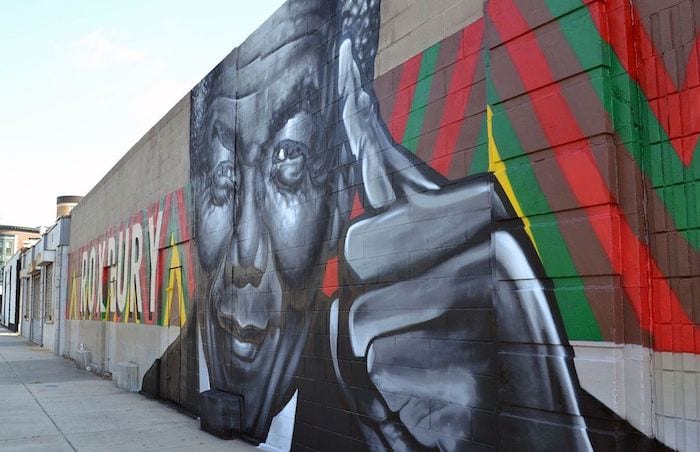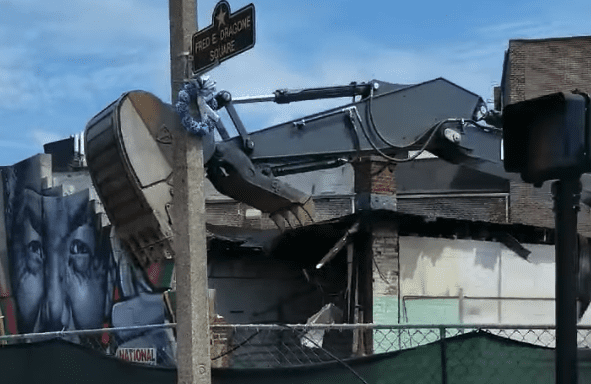
“It was to create a different municipality that was a majority of people of color and working class folks, because we wanted a seat at the table.”
In July, a mural in Roxbury came down.
The work was of South African leader Nelson Mandela, set against a colorful backdrop and situated in between the words “Roxbury Love.” Beloved by the community, the painting could be found at the intersection of Warren and Clifford Streets, and was created by the artist Ricardo Gomez, also known as Deme5.
As has become widely known in the wake of a public outcry, the mural was demolished to make way for apartments. The site is being developed by the Roxbury-based Cruz Companies, which plans to construct 99 residential housing units, along with an office space, a coffee shop and restaurant, and a two-level garage there.
Toy Burton, executive director of the Roxbury Unity Parade, said upon hearing about the demolition, community members were upset, even angry.
“It just symbolized Roxbury,” Burton said. “It just felt like home. It would be like if people in New York woke up and the Statue of Liberty wasn’t there. That wall, as temporary as it was, it was still just a symbol of Roxbury. …You could tell that it was made for us.”
The mural was commissioned as a temporary work of art in 2014, as part of the city’s “Pop Up! Dudley Connections” program, which was intended to create nonpermanent public and performance art projects in the Nubian Square area, then called Dudley Square. While Gomez said that he understood that the mural would eventually come down, he had been speaking with Cruz Companies in December and January about its future, stating that nothing was finalized through these meetings. He had requested a planned date of demolition and never received a notification. During a time of “racial turmoil and the ravages of Covid19,” Gomez said that the destruction was badly timed.

“It is also a representation of how communities of color throughout the United States are ignored, overlooked, and seen in some respects as not having value,” said Brandy Brooks, director of operations for the Roxbury Unity Parade. “Because if you do that to the community, what else have you done or will you do? The mural kind of is a symbol and is a representation of some of the issues going on locally and nationally. If you look at it in the sense of police brutality, you don’t value my blackness, so of course you don’t value my art. There could be a micro/macro lens to looking at the mural and its destruction.”
Black artists continue to struggle with the impact of gentrification in the neighborhoods where they live and work, said Alex Ponte-Capellan, an organizer with City Life/Vida Urbana. He said that he has seen the demographics of neighborhoods like Roxbury change over the years, with many young professionals moving in and displacing artists, who have been pushed out due to rising rents. In the South End, another symbol of Black culture, the Harriet Tubman House, a multi-use community center, and the iconic Honor Roll mural, will be coming down to make way for condominiums. Ponte-Capellan said that it is difficult for artists to find spaces to work or show their art, as many opportunities have vanished, due to gentrification and speculation, and compounded by racism.
To Ponte-Capellan, the Nelson Mandela mural is steeped in history. In the 1980s, a grassroots organization called the Greater Roxbury Incorporation Project proposed an initiative, calling for neighborhoods including Roxbury, Dorchester, Jamaica Plain, and the South End to secede from Boston. As a response to gentrification and equity issues, these communities would form their own Black majority municipality, called “Mandela.” The formation of Mandela would be a form of resistance, an assertion of independence, and a way of reclaiming space, a movement that would speak to anti-colonial struggles across the world. While the idea to create Mandela never came to fruition, as the vote never passed, Ponte-Capellan said that the Mandela mural, while not directly reflecting this history, reminds him of the possibility of that city.
“When I think about Mandela, I think about people’s control over what they want,” said Ponte-Capellan. “Because essentially, that’s what that idea was all about. It was to create a different municipality that was a majority of people of color and working class folks, because we wanted a seat at the table. We wanted to be able to influence decisions that would affect us. That’s not what’s happening now. We’re seeing buildings come up all around us, and a lot of times, folks don’t even know that these things are happening …When I look at a mural of Mandela, I remember the fight …I feel like there was a lot of potential there, for something good, but the energy and people it took to create that idea and push it forward, we’re still here.”
Artists of color have continued to face obstacles relating to their right to work spaces, as seen in a long-simmering conflict with Northeastern University. The school’s African American Master Artists-in-Residence program (AAMARP) found itself locked out of its building this past June. The university had changed the locks to the space without notifying the group, a situation that led to a protest outside the building. While Northeastern stated that this was done as a response to the pandemic, members of AAMARP see the action as part of a continued attempt to push out artists of color.
“What’s important is that we have been locked out—we have a situation where we’re not able to operate with our supplies and equipment, the way that artists should be able to do,” said AAMARP artist L’Merchie Frazier. “We have not reached a point where we have identified a location that is being prepared for us to go to. In this country, there is this moment of either embracing what equity is and equity for artists in any city is. Racism has been declared in the City of Boston as a part of the health issue here. So this is where we stand.”
Brooks said that works of art are essential to preserving cultural identity, as they add richness and depth to histories. Without them, aspects of the narratives that a people may tell would fade away.
“It’s the stories. …Having those artifacts exist, to be able to visit and see those artifacts is important. Because without that, imagine what stories we would tell,” Brooks said. “…You need those artifacts, whether it is the physical structure, or a paper, or a palette, or anything—you need those artifacts, because they tell us where we have been, where we are, and where we’re going. And that’s important to be able to pass on for future generations.”
Shira Laucharoen is a reporter based in Boston. She currently serves as the assistant director of the Boston Institute for Nonprofit Journalism. In the past she has written for Sampan newspaper, The Somerville Times, Scout Magazine, Boston Magazine, and WBUR.

